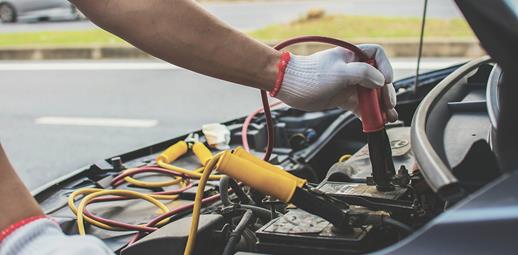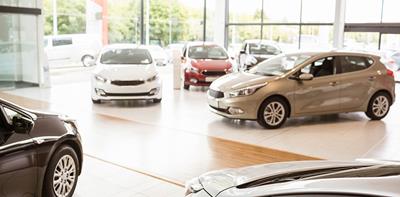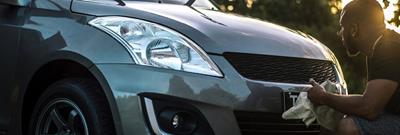
Leaving your car’s lights on overnight. Freezing temperatures. Or an old or poorly maintained battery. All these can quickly lead to an engine that fails to start.
But a flat battery doesn’t have to ruin your day. With jumper cables and equipment, you can jump start your car from another vehicle’s battery or a battery pack and get on your way.
How to jump start your car with cables
Flat batteries happen all the time but if you have never used cables to jump start a car, it can be daunting. Follow our step by step guide to help you jump start a car safely.
EASY AS HACK
Use high-quality thick jump leads to improve your chances of a successful jump start. Lightweight cables may be cheaper but they can’t take the load needed to jump start a car battery. A 5-metre cable should be long enough [1].
At a glance
- Read the pages of your owner manual before jump starting the car as each model differs.
- Batteries contain acid, so always wear thick gloves and safety goggles
- Consider buying a booster battery to keep in the boot when there’s no other vehicle around
What you need to jump start your car
Before you begin, gather all the equipment you need to jump start the car:
- Black negative (-) and red positive (+) jump leads with insulated terminal clamps
- A second donor car with a charged battery (or a portable battery pack)
- Thick gloves and goggles for safety
Safety advice before jump starting a car
Incorrect use of jump leads and batteries could damage the car’s electrical system or cause injuries such as burns and shocks, so be careful. If you’re unsure, then it’s best to get in touch with a reputable mechanic or garage who can help.
- Check that the battery isn’t leaking or is damaged [3]. The acid in a battery can burn the skin. Do not begin the jump start. Get advice from a professional [4].
- The jump leads must be insulated and heavy to carry the current. Do not buy cheaper booster leads that aren’t thick enough to get the current from one car to another. Never use faulty leads, as they could cause overheating.
- Never work by naked flames or someone who is smoking. Keep them far away from the battery. The risk of an explosion is genuine if a spark ignites the hydrogen gas generated inside a car’s lead-acid battery [5].
- Remove jewellery [6] like wristwatches, rings and bracelets, as metal items are electrical conductors that could heat up and cause burns or shock. Another potential hazard is a spark and explosion if the metal touches the battery terminals.
- Take the key out of the ignition [7]
How to jump start a car with another car
1. Switch off any electrical systems or devices
Before you try to jump start a car, the first step is to turn off electrical items in the other car [8], such as heated windows and seats, the blower fan, and headlamps [9]. You want to limit the electrical load and create as much battery capacity as possible.
2. Locate the vehicle battery
Put your gloves [10] and goggles on before opening the bonnet.
A battery is usually located in the engine bay, but it could be in the boot in some vehicles [11]. A connection point may be under the bonnet even if the battery is in the boot, so you can still jump-start it. If in doubt, check the owner manual.
Look to see whether the voltage of one battery is the same as the other. Batteries are usually 12 volts. Do not try jump-starting with a car that has a hybrid or electric battery [12].
Identify the battery’s positive (+) and negative (-) terminals [13]. They are marked on the battery or its plastic lid. Typically, there’ll be plus and minus signs with cables connected to them – black for negative and red for positive. Check that the cables can reach both cars [14].
3. Line up both cars closely
Move the donor car to face the front of the vehicle with the flat battery or alongside it [15]. The idea is to get both cars close enough so the jump leads can reach between them while ensuring they don’t touch.
4. Ensure both cars’ engines are completely switched off
To be safe, turn the ignition off in both cars [16], put the gearstick in neutral, and put the handbrakes on [17].
5. Connect the red jump lead first
Now, start connecting the jump leads to the battery. You must continue in the correct order [18]. The most significant danger when jump-starting a car is incorrectly attaching jump lead cables, which could result in a short circuit and the battery could explode.
Flip open the plastic cover (if there is one) and connect the red positive (+) wire to the dead battery's positive terminal [19] using the alligator clip. Make sure the grip is secure. Second, connect the other end of the red lead to the positive terminal of the good battery in the donor vehicle [20].
6. Connect the black jump lead second
Next, connect the black jump cable to the good battery's negative (-) terminal [21]. For safety, do not connect the second negative clamp to the negative terminal on the dead battery. Instead, attach the clamp onto a solid piece of bare metal in the car away from the fuel system [22] and the battery, such as a bolt head on the engine block [23]. It acts as an earthing point [24] and reduces the risk of a spark and an explosion, which could happen if you attach the final black clamp to the drained battery [25].
Keeping one lead with one colour in your hands at any time is a good idea to avoid making a circuit and risking electrocution. When connecting the batteries, do not let the leads touch the car's metal or the other clamp until you have disconnected.
7. Wait for five minutes after connecting the jump leads.
When the jump leads are connected, you have created a circuit [26]. Wait for five minutes [27].
8. Start the car's engine with the charged battery and let it run for a minute.
Start the other car’s engine and keep it running for a minute [28]. Gently increase the revs to above idle [29] to produce enough speed to generate more energy to transfer to the dead battery.
9. While the engine of the charged car is still running, try to start the engine of the car with the flat battery
The voltage increases as you rev the other car, allowing the battery to work better. Now, you can try to start the engine of the first car with the dead battery [30].
10. Let both cars run for 10 minutes
Running both cars for 10 minutes [31] will allow the flat battery to charge. Turn the engine off and disconnect your last connection if it doesn't fire up. Then, jiggle the clamps on the terminals to improve the connection. Try again [32].
11. Turn off both cars
Switch both cars’ engines off [33].
12. Disconnect the jump leads in the following order:
- Black lead attached to the car with the flat battery
- Black lead connected to the vehicle with the charged battery
- Red lead attached to both cars [34].
Do not let metal components touch each other [35]. Replace the plastic flip-lids on the batteries if they have them [36].
13. Restart your car and leave it running for around 20 minutes before driving it
Once you have restarted the engine, the battery will take some time to recover. Drive it around for 30 minutes [37], but turn off the heated seats, windows and other equipment to allow the battery to recharge completely.
How to jump start a car with a portable battery pack
1. Check the battery pack is fully charged
You might want to keep a battery booster pack in the boot in case you can’t find another vehicle to help; and you need to jump start the car by yourself. Remember to keep the battery pack charged [38]. If you have left it in the boot for six months, the chances are it will be flat [39]. Make sure you also buy one that’s big enough for your car.
2. Place the battery pack on the ground, close to the vehicle
Put the battery booster pack on a flat surface, preferably the ground [40]. It should be close to the vehicle so the jump leads can reach the battery.
3. Locate the vehicle battery
Open the bonnet to find the vehicle battery’s location. It could be under the bonnet or in the boot. Also, check the battery voltage. Most batteries are 12V, but the owner’s manual should tell you. Read the instructions with the battery pack to check whether it’s appropriate for a 12V or whatever voltage battery you have. The owner’s manual will tell you if you’re unsure.
4. Connect the positive red jump leads
When you’re ready, put on gloves and goggles for protection. Turn off the ignition. Connect the positive (+) jump lead with the booster pack to the flat battery's positive (+) terminal [41].
5. Connect the negative black jump leads
Next, connect the negative (-) black jump leads to an earthed bare metal part in the engine bay [42]. It should not be near the fuel system or the battery.
6. Switch on the battery pack and leave it running for a couple of minutes
Switch on the battery pack once it’s connected to the dead battery [43].
7. Attempt to start the vehicle
Try starting the engine and gently increasing the revs to about 2,000rpm to generate enough power to transfer to the flat battery.
8. Once the vehicle starts, keep the engine running for about 10 minutes
Keep the engine running to make sure it works. At least 10 minutes should do it [44].
9. Switch off the engine, switch off the battery pack, and then remove the cables
Turn off the ignition and the battery pack. Remove the jump leads from the booster pack [45] in the reverse order that you connected them (the black first, then the red).
10. Restart the engine again
Now, you can restart the engine and drive the car for about half an hour to recharge it. You should recharge the battery completely using a quality car battery charger [46].
How long does it take a battery to charge after a jump start?
It takes about 30 minutes to charge the battery after a jump start. You should leave your car running while stationary before taking it for a drive to recharge the battery [47].
What happens if your car’s not starting after a jump start?
If your battery still isn’t charging correctly or doesn’t start after jumping, you will probably need a battery replacement [48].
But the car not starting depends on why the battery is flat. You may have killed the battery if you left the lights on over the weekend [49]. If you go out on a cold day and it has not jump-started, the chances are that it’s dead. It’s time to seek professional help.
Ageas car insurance can help protect you from breakdowns and battery failure. You can add an optional breakdown cover that includes RAC roadside assistance and local vehicle recovery.
FAQ’s
What is the correct order to jump start a car?
- Connect the red positive (+) wire to the positive terminal on the flat battery
- Attach the other end of the red lead to the positive terminal of the good battery
- Connect the black jump cable to the negative (-) terminal of the good battery
- Attach the second negative clamp onto a piece of bare metal in the car away from the fuel system and the battery [50].
What gear do you jump start a car in?
You jump start a car in neutral [51]. Do not put either car in gear.
Do you connect red or black first when jump starting a car?
When jump-starting the vehicle, you connect red jumper cables first, starting with the positive terminal of the car with the dead battery [52].
Does revving help you jump start your car?
Revving will help you jump-start your car but do it gently. Keep the revs at about 2,000 rpm [53].
How to safely remove the jump leads
To remove the jump leads safely, take them off the battery in reverse order:
- Disconnect the black lead to the car with the flat battery
- Disconnect the black lead attached to the vehicle with the good battery
- Finally, disconnect the red lead connected to both cars [54].
Can you jump start a car in the rain?
Yes, you can jump-start a car in the rain. It’s not dangerous as most batteries are 12 volts – not powerful enough to injure you [56].
Is your insurance as easy to trust as Ageas?
With over 3 million UK customers, get your Ageas car insurance quote today.
For more handy motoring tips and guides, go to Solved
Sources
[1,2,48,51] https://haynes.com/en-gb/tips-tutorials/how-jump-start-car-leads-guide
[3,22,47] https://www.theaa.com/breakdown-cover/advice/using-jump-leads
[4,6,7,10,24,27,30,31,34,35,54] https://www.halfords.com/motoring/how-to-guides/how-to-jump-start-a-car-guide.html
[5] https://preventblindness.org/how-to-jump-start-a-car-battery-safely/#:~:text=Never%20smoke%20or%20use%20anything,exposed%20wires%20on%20your%20cables.
[8,11,32] https://www.caranddriver.com/features/a26801962/how-to-jump-start-car/
[9,15,28,36,43,44,50] https://www.wikihow.com/Jump-Start-a-Car
[12,13,14,16,18,55] https://www.rac.co.uk/drive/advice/car-maintenance/how-to-jump-start-a-car/
[17,19,20,21,23] https://www.lookers.co.uk/car-advice/car-maintenance/how-to-jump-start-your-car-using-jump-leads
[25] https://community.cartalk.com/t/jumpstart-why-does-black-get-grounded-and-not-hooked-to-negative-on-dead-battery/72155
[26,29] https://www.physicsforums.com/threads/giving-a-jump-start-to-a-car-how-does-the-circuit-become-complete.984567/page-2
[33,37,38,45,46] https://www.rac.co.uk/drive/advice/car-maintenance/how-to-jump-start-a-car/#how-to-jump-start-a-car-with-jump-leads
[39,52] https://www.autosimple.com/blog/how-to-use-portable-jump-starter/
[40] https://www.rac.co.uk/drive/advice/car-maintenance/how-to-jump-start-a-car/#:~:text=Jump%20starting%20with%20a%20portable%20battery%20pack&text=Connect%20the%20positive%20(red)%20lead,the%20engine%20is%20usually%20best.
[41,42] https://www.webuyanycar.com/guides/car-maintenance/jump-starting-a-car/
[49] https://www.rac.co.uk/drive/advice/know-how/what-to-do-if-you-have-a-flat-battery/#:~:text=We've%20already%20learned%20that,unnecessarily%20or%20mistakenly%20when%20parke
[52] https://eu.dispatch.com/story/business/2007/04/28/it-s-good-to-rev/24137653007/#:~:text=When%20an%20alternator%20turns%20faster,donate%20to%20the%20other%20car.
[56] https://www.dailynews.com/2018/03/02/need-to-jump-start-your-car-in-the-rain-heres-how-to-do-it-safely/

